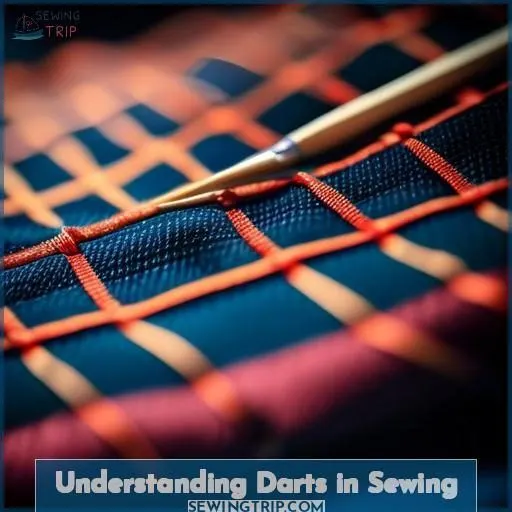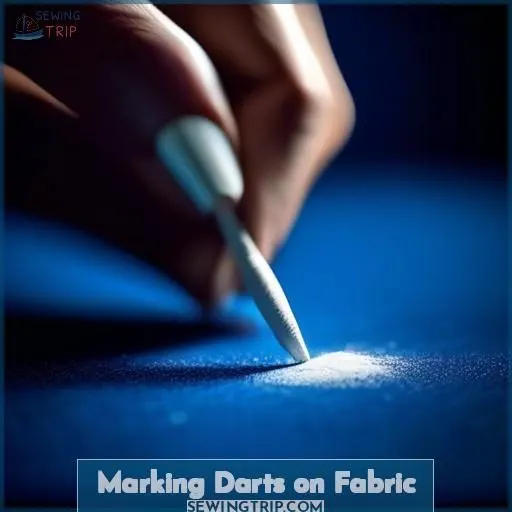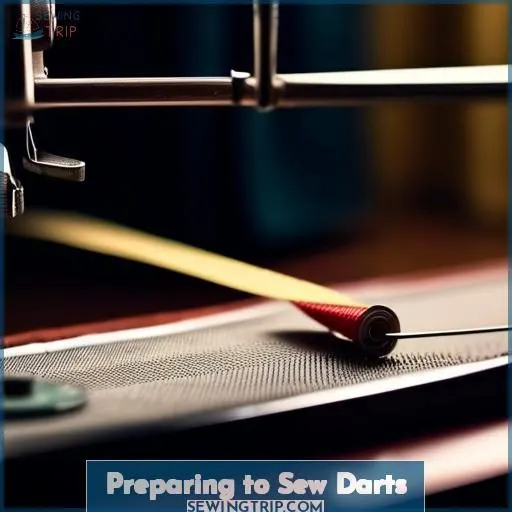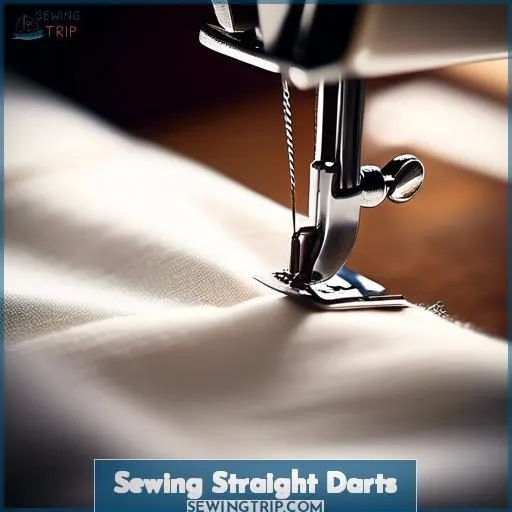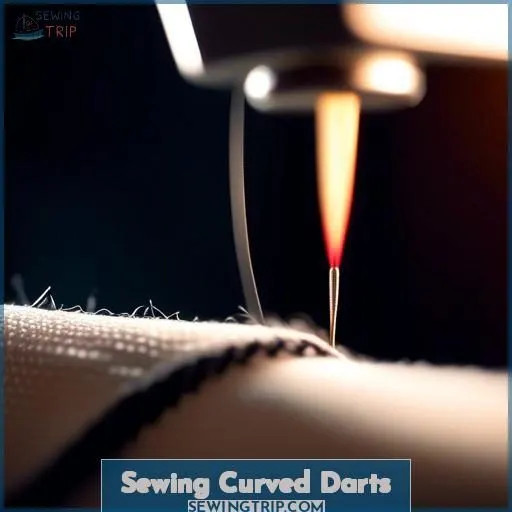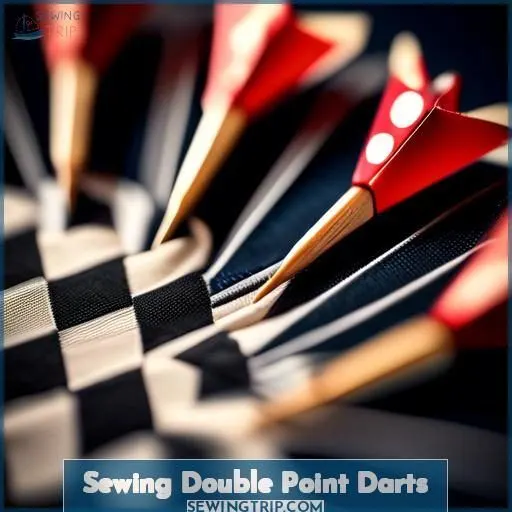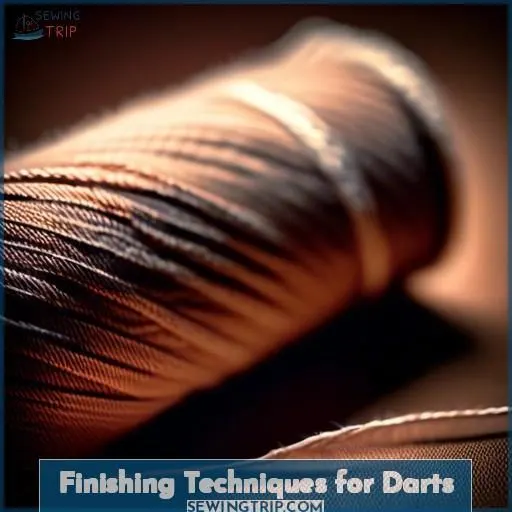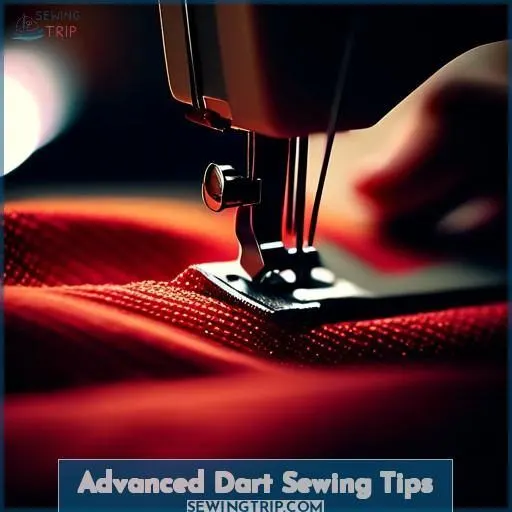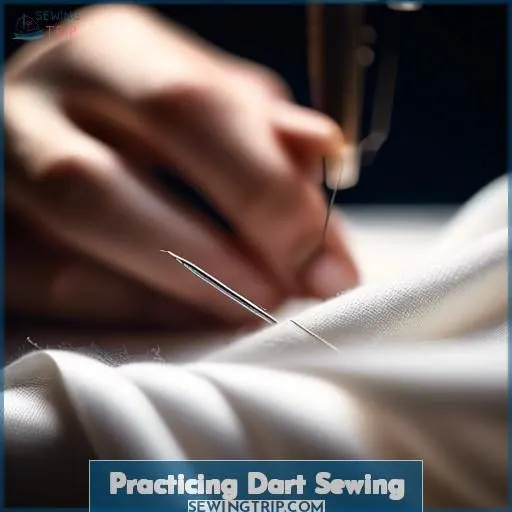This site is supported by our readers. We may earn a commission, at no cost to you, if you purchase through links.
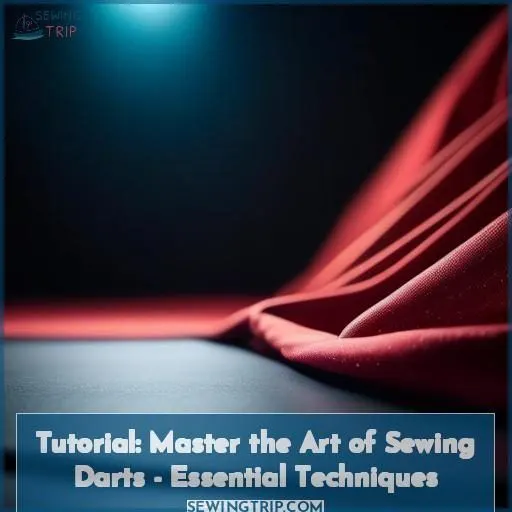
To sew a dart, start by folding the fabric right sides together, aligning the dart markings. Securely pin the dart in place with pins perpendicular to the fold. Use an appropriate stitch length and tension, tapering the stitches as you approach the dart point. Secure the stitches at the beginning and end of the seam.
Press the dart to set the shape. Sewing darts takes practice, but by following these steps, you’ll be able to create a flattering, form-fitting garment.
Table Of Contents
- Key Takeaways
- How to Sew a Dart?
- Understanding Darts in Sewing
- Types of Darts
- Marking Darts on Fabric
- Preparing to Sew Darts
- Sewing Straight Darts
- Sewing Curved Darts
- Sewing Double Point Darts
- Finishing Techniques for Darts
- Advanced Dart Sewing Tips
- Practicing Dart Sewing
- Frequently Asked Questions (FAQs)
- Conclusion
Key Takeaways
- Align dart markings, fold fabric right sides together, and securely pin the dart in place with pins perpendicular to the fold.
- Use an appropriate stitch length and tension, tapering the stitches as you approach the dart point.
- Press the dart to set the shape after sewing.
- Precision is paramount in the realm of darts, so consistently consult your pattern for accurate markings.
How to Sew a Dart?
To sew a dart, first mark and pin the fabric according to the dart’s dimensions, then stitch along the marked line, tapering off at the dart’s point. This technique shapes garments by creating a fold of fabric that’s sewn to contour to the body.
Understanding Darts in Sewing
Darts are an essential shaping tool in sewing, allowing you to create flattering silhouettes for your garments. By understanding the placement and purpose of darts, you can master the art of tailoring your clothing to accentuate your unique figure.
Shaping With Darts
Darts are essential shaping tools in sewing, providing a snug fit and flattering silhouette. They come in various lengths, widths, and shapes, with common placement around the bust area.
Understanding dart placement and purpose is key to successful dart construction. Precise markings, folding, pinning, and stitching techniques are vital for dart shaping and finishing.
By mastering these skills, you’ll create seamless, shapely darts that enhance your garments.
Dart Placement and Purpose
Now that you grasp the fundamentals of shaping with darts, it’s time to explore the intricacies of dart placement and function. Darts aren’t solely confined to conventional fabrics; they can also be employed on fabrics with elasticity.
Various dart designs, such as darts with a curved shape and darts with dual points, fulfill distinct objectives. The positioning of darts on different garments, such as dresses or blouses, can vary according to the desired outcome.
Bear in mind that precision is paramount in the realm of darts, so consistently consult your pattern for accurate markings.
Types of Darts
Ah, the diverse types of darts! Let’s start with the straight dart – its singular point and linear legs give you the foundation for shaping. And don’t forget the curved dart, whose graceful contours hug the bust beautifully. Of course, the double point dart brings its own challenges, with two distinct points that require careful handling.
Straight Dart Characteristics
Straight darts are a versatile shaping tool in sewing, often used to add structure and definition to garments. They come in various sizes, with dart interfacing providing support and stability.
Dart stitching machines facilitate accurate placement and stitching. Practice methods include using fabric markers to mark dart points and seam allowances.
Straight darts can be found on various garments, from casual wear to formal attire. Choose your dart fabric wisely, considering factors like drape and stability.
Curved Dart Contouring
Curved darts are your secret weapon for mastering fabric contour. Here’s how to nail them:
- Use tracing paper and a tracing wheel to transfer the curved dart outline—precision is crucial.
- Fold the fabric along the dart line, ensuring precise folding for a perfect fit.
- Pin carefully, respecting seam allowances for a smooth silhouette.
- Sew with a tapered stitch, guiding the fabric gently to follow its curves.
Double Point Dart Structure
Mastering the art of sewing double point darts is a game-changer for your garment-making skills. These darts, with their two pointed ends, offer advantages like precise shaping and a smooth silhouette.
But they also come with challenges, such as handling the fabric stress and ensuring a perfect dimple-free finish. To get started, use tailor’s chalk to mark your darts, then fold and pin them with care. Sew along the marked lines, tapering slightly before reaching the point, and clip the center of long darts.
Finish by trimming seam allowances and pressing from the right side. With practice, you’ll be sewing double point darts like a pro!
Marking Darts on Fabric
When stitching darts, it’s imperative to precisely indicate the placement of the dart on your fabric. Employing the pattern as a guide, meticulously copy the dart markings onto your fabric with tailor’s chalk, fabric marker, or pencil to guarantee exact positioning.
Using Patterns for Dart Placement
Regarding sewing darts, their placement is paramount for obtaining the intended fit and style. Utilizing patterns for dart placement is vital in this process. Here’s how you can employ patterns to mark and position darts precisely:
-
Follow the pattern markings: The majority of sewing patterns feature dart markings on the pattern pieces. These markings indicate the location and width of the darts. Use them as a guide for accurate placement.
-
Consider fabric and fit: The type of fabric used and the desired garment fit can impact dart placement. For instance, heavier fabrics may require multiple darts for reinforcement, while lighter fabrics mightn’t necessitate as many. Additionally, the garment’s shape (e.g., fitted vs. relaxed) can influence dart placement.
-
Adjust for style: Different garment styles may dictate specific dart placements. For example, a tailored blouse might’ve darts placed at the bust and hip, while a straight skirt might’ve darts at the waistline. Acquaint yourself with the customary dart placements for the garment style you’re sewing.
Importance of Accurate Marking
Accurately marking darts is essential for achieving precise sewing results. Transferring pattern markings to fabric guarantees that darts are positioned correctly.
Cross-marking perpendicular lines before dart points aids in maintaining alignment. Folding and pinning darts with right sides together, with pins facing away from dart points, ensures secure stitching.
Stitching along marked lines, tapering seams, and adjusting angles for dart points all contribute to dart precision.
Preparing to Sew Darts
Fold your dart right sides together, making sure the markings line up precisely. Securely pin the dart in place, with the pins running perpendicular to the fold and pointing away from the dart point.
Folding Techniques
- Folding Accuracy: Folding darts with precision is essential for a garment with a well-defined shape.
- Folding Instructions: Follow these steps to fold your darts accurately:
- Fold the right sides together.
- Align the lines precisely.
- Insert pins along the line, pointing away from the dart tip.
- Pin the dart tip.
- Press flat using your fingers or an iron.
- Fabric Handling: Treat your fabric gently during folding to prevent wrinkles or damage.
- Pin Positioning: Make sure pins are placed along the fold line correctly for seam alignment.
- Seam Alignment: The folded dart should line up with the seam line for a seamless finish.
Pinning for Precision
Pin placement is your secret weapon for dart precision. Think of it as mapping your route before a road trip.
Aim those pins along the dart line, pointing away from the dart point like arrows fleeing the scene. The right pin density keeps fabric from playing hooky under your needle.
Removing pins as you sew isn’t just safe—it’s a stitch in time!
Sewing Straight Darts
When sewing straight darts, it’s important to use the right stitch length and tension. Start by stitching at 2.0 mm, then taper your stitches to 1.0 mm as you approach the dart point to guarantee a smooth, secure finish.
Stitch Length and Tension
To sew straight darts, you should consider the stitch length and tension settings on your sewing machine. For lightweight fabrics, a shorter stitch length of around 1.5 to 2 mm is recommended. For heavier fabrics, use a longer stitch length of around 3 mm to 3.5 mm.
Additionally, adjusting the tension setting can help prevent puckering and guarantee smooth stitching. Remember to start stitching at the widest part of the dart, backstitching if necessary, and gradually decrease the stitch length as you approach the dart point. Secure the stitching at the dart point and avoid backstitching at the tip, instead tying off the thread or using a lock-stitch.
Tapering and Securing Ends
To become adept at sewing straight darts, you’ll need to taper the seam and secure your stitches. Here’s a step-by-step guide:
- Tapering Seam: Shorten stitch length to 1.0 mm before reaching the dart point.
- Securing Stitches: Make sure your stitches are secure at the beginning and end of the seam.
- Tension Adjustment: Adjust tension for the best results.
- Fabric Stress: Relieve stress by snipping the center of long darts.
- Knot Tying: Tie thread tails at the end to prevent unraveling.
Sewing Curved Darts
Sewing curved darts requires finesse as you’ll need to adjust the fabric contour to create a smooth, sculpted look. Take your time aligning the fabric edges and use short, controlled stitches to follow the curved dart line without puckering the fabric.
Handling Curved Lines
Handling curved lines in sewing curved darts can be a challenge, but with practice, you’ll master it. Start by creating a 3×4 table to visualize your dart’s contouring process. Use a curved seam allowance to contour fabric without causing fabric stress. Taper edges to maintain shape and place points correctly. Remember, precision is key to avoid puckering.
Keep practicing and you’ll soon be sewing curved darts like a pro!
Adjusting for Fabric Contour
When sewing curved darts, it’s essential to adapt for fabric contour. Start by verifying the dart orientation aligns with the fabric grainline. Modify seam allowances for fabric draping, and contemplate utilizing interfacing for additional reinforcement. Collect fabric at the dart point, and alter the curve as necessary for a seamless line. Remember, perseverance and practice will yield impeccable darts.
Sewing Double Point Darts
Sewing a double point dart necessitates handling the two distinct points. Additionally, it’s essential to trim the center of extended darts to mitigate any fabric strain and guarantee a seamless, aesthetically pleasing outcome.
Managing Two Points
To sew double point darts, follow these steps:
- Trace the dart onto tracing paper or mark the sides and points.
- Fold the dart, matching the lines, and pin as you go.
- Start sewing in the middle of the dart, sew to the end, and repeat for the second leg of the dart.
- Clip the center of long darts to relieve fabric stress.
Relieving Fabric Stress
Relieving fabric stress while sewing double point darts can be achieved through a few key techniques. First, you can clip the darts to mark their placement and make sure they align properly. This can be done using a handheld needle threader or by clipping the fabric along the dart legs.
Next, you can use a dart presser to press the darts into the desired shape. This tool can help maintain the dart’s shape and prevent any distortion during the sewing process.
When hand basting the darts, you can use a longer stitch length and sew from the edge of the fabric piece to the tip of the dart. This will help guide you in sewing the dart accurately.
For angled darts, you can adjust your stitching angle to match the dart’s curve. This will help maintain the dart’s shape and prevent any puckering or distortion.
Lastly, when sewing the dart, you can use a continuous thread sewing technique. This involves removing the upper thread from the needle and threading the bobbin thread backwards through the needle. This method can help maintain the dart’s shape and make sure the sewing is accurate.
Finishing Techniques for Darts
After you’ve sewn the dart, be sure to knot the thread tails at the dart point to prevent unraveling. Then, press the dart from the right side using a pressing ham or your fingers to create a smooth, shapely finish.
Knotting and Trimming Threads
After sewing those double-point darts, it’s time to tidy up loose ends—literally. Knotting at the dart points guarantees your work won’t come undone, lending your seam finish its resilience. Preserve enough thread length prior to snipping off excess; it’s similar to trimming your darts neatly. This action is your private pact into the realm of refined, expert-caliber garments.
Pressing for Smoothness
Now that you’ve knotted and trimmed your dart threads, it’s time to press for a smooth finish. Dart pressing is essential for achieving a professional result. Use pressing equipment like a pressing ham or dart press to establish the dart shape. Apply heat and steam, adjusting for fabric texture. Press delicately to avoid damaging the dart or altering the shape.
With practice, you’ll master the art of dart pressing, ensuring your garments look fantastic every time.
Advanced Dart Sewing Tips
Avoid puckering by sewing darts slowly and carefully, applying minimal tension on the fabric. When working with sheer fabrics, baste the dart in place first to guarantee a smooth, wrinkle-free finish.
Avoiding Puckering
Avoid Puckering: 4 Tips to Master Dart Sewing
- Correct Needle and Thread Tension: Make certain your needle is sharp and thread tension is suitable for your fabric.
- Choose the Right Fabric: Select a fabric that doesn’t pucker easily, like a sturdy knit.
- Optimize Stitch Length: Adjust stitch length for the fabric you’re using, shorter for delicate fabrics.
- Pressing Technique: Use a pressing ham to press the dart from the right side, avoiding unnecessary wrinkles.
Sewing Sheer Fabrics
Sewing sheer fabrics can be a challenge, but with the right techniques, you can create beautiful, smooth darts. Start by sewing bias tape along the dart line to stabilize the fabric. Interfacing can also be used for added support.
Choose a smaller needle size to prevent the fabric from bunching. Handle slippery fabrics with care, using a light touch and smooth strokes.
When sewing curves, adjust your stitch length and tension to maintain control.
With patience and practice, you’ll master sewing darts in sheer fabrics.
Practicing Dart Sewing
Practice leads to perfection in the realm of sewing darts. Experiment with various techniques using fabric scraps and seek guidance from sewing forums or communities for supplementary advice and understanding.
Using Scrap Fabric
Using Scrap Fabric to Practice Dart Sewing
- Reusing Fabric Scraps
- Use leftover fabric from previous projects to practice sewing darts.
- This is a cost-effective way to experiment with different fabrics and techniques.
- Recycling Fabric Leftovers
- Repurpose small pieces of fabric into dart practice pieces.
- This reduces waste and helps you become more resourceful in your sewing.
- Experimenting on Different Fabrics
- Try sewing darts on various types of fabric, such as linen, cotton, or silk.
- This allows you to understand how different fabrics behave when sewing darts and adjust your technique accordingly.
Learning From Community Tips
To master the art of sewing darts, it’s vital to seek guidance from the sewing community and utilize online resources, expert advice, and group projects. Here are some tips to help you perfect your dart sewing:
- Community Feedback: Join online forums and social media groups dedicated to sewing, such as the Sew Daily community or the Sewing subreddit. These platforms provide a wealth of information and advice from experienced sewers who can share their tips and tricks for sewing perfect darts.
- Online Resources: Utilize blogs, tutorials, and video content to learn different sewing techniques. For example, the Friday Pattern Company offers a free dart practice template that you can use to hone your skills. Additionally, YouTube channels like the Awl Nighter provide step-by-step video tutorials on sewing darts.
- Expert Advice: Seek out sewing books, classes, or workshops taught by professional seamstresses or tailors. They can provide valuable insights into the art of sewing darts and help you refine your technique.
- Group Projects: Participate in group sewing projects or sewing bees, where you can work alongside other sewers and learn from each other’s experiences. This can be an excellent opportunity to practice sewing darts and receive feedback on your work.
- Peer Review: Share your work with other sewers and ask for their honest feedback. This can help you identify areas for improvement and learn new techniques from others.
Frequently Asked Questions (FAQs)
What is the purpose of darts in sewing?
Darts are sewing magic! They shape fabric to fit your curves, creating a fabulous fit. From bust to hips, darts sculpt and smooth, giving you the perfect silhouette. Embrace the power of darts – they’re your style secret weapon!
How do I sew a dart on a curved seam?
Imagine this – the material gently bending around your fingertips, as you skillfully direct it through the device. With a few strategic pins and consistent stitches, stitching that curved dart is effortless. Let’s begin and accomplish it!
Can I use pins to mark dart points?
Pins are ideal for marking dart points. Just place a pin precisely at the marked spot to identify the dart location. This guarantees an accurate fold and stitch when sewing the dart.
How do I avoid puckering when sewing darts?
Afraid of puckered darts? Try securing the start and end with a knot, angling your stitches, and pressing firmly. Does that sound like the solution you were looking for? With a little practice, you’ll be sewing flawless darts in no time!
What are some common mistakes to avoid when sewing darts?
Don’t sew darts too tightly, inadvertently gather the fabric, or fail to taper the ends. Avoid these common mistakes – your darts will lay flat and flatter your figure beautifully.
Conclusion
Alas, the skill of stitching darts escapes the ordinary. Fear not, esteemed reader, for this thorough guide has shed light on the enigma of the dart. By adhering to these instructions, you’ll sew darts akin to an experienced tailor, transmuting your garments into masterpieces.
Harness the potency of the dart, and open up a realm of flattering, figure-flattering style. Hence, grasp those needles and yarn, and sew those darts with unwavering conviction – the sartorial transformation begins here!

